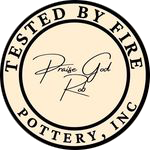Uncategorized
Three more steps in the process. Waxing, Glazing and Decorating
Step 7: Waxing the Bottom and or Rim
After applying the signature and before glazing the piece, the bottom has to be waxed. This will also include the rim of any piece that has a lid. The wax is paraffin that is heated up to somewhere between melting and the paraffin’s flash point. We adjust the temperature by sight. If the wax is smoking, it is too hot, and if it is not sticking soundly to the bottom or rim it is not hot enough. Since we are working with greenware, we keep the wax hotter than we would if the pot had been bisquefired before this step.
Step 8: Glazing
Green Glazing Since we single fire the pottery, we have to handle the greenware in specific ways to keep the piece from developing defects. The first step is to alter the glaze so it stays on the piece as it shrinks in the early stages of the firing. Most of the shrinkage occurs before the glaze begins to melt and if the glaze is not designed to adhere to the clay the glaze will fall off the piece like a snake shedding its skin. The glaze then melts to the kiln shelf creating a mess.
Usually, a glaze that used for single fire has more clay in it. The easiest way to adjust a glaze for green glazing is to add 1 to 3 percent bentonite to the glaze. Bentonite is a very fine-grained clay that is often used to keep glaze in suspension, but in this case it sticks the glaze to the greenware.
We glaze each piece when it is bone dry by either pouring or dipping. Usually we glaze the inside first and then allow it to dry overnight. Then, we apply glaze to the outside. We used to dip a piece all at once, but we discovered that the piece absorbed too much water causing defects to appear after the firing. With dipping, there was a greater chance of pop-outs occurring which are raised areas on the surface of the piece and cracks on the rim.
When we glaze larger pots such as platters and larger bowls, we pour the glaze over the piece. These pieces are often to heavy to dip and would also require a larger amount of glaze.
Step 9: Decoration
After the glaze has dried it is time to apply the decoration. The first step is to apply an oxide mix of red iron oxide and rutile to the surface of some of the specific glazes that we use. One such glaze is the copper red glaze which is one of the glazes in the Cosmos glaze pattern and the blue glaze in the New blue glaze pattern. The oxide mix reacts to different glazes changing the color of the glaze. The copper red glaze is made with a wide (about two inches) flat brush called a Hake brush. After the oxide is applied I use a bottle to apply a Copper Red Glaze and a depending on the surface, a blue glaze. There is a video attached where I am decorating a dough bowl.
